Offshore wind farm developments - public perceptions: survey
Findings from a survey exploring public perceptions of offshore wind farm (OWF) developments in Scotland. It describes whether and how respondents in Scotland have been impacted by OWFs, their attitudes to OWFs, and how OWFS affect their tourism and recreation choices.
This document is part of a collection
2 Perceptions of and attitudes towards Scotland's marine industries
2.1 Social value of marine industries to Scotland
Respondents were asked for their opinions on the social value (the value to society as a whole or to local communities) of various sectors and industries. Most sectors and industries receive positive net importance ratings in terms of social value from national respondents (see Figure 2.1). The exception is military exercises where opinion is fairly evenly split (45% important, 48% as not important). Almost all national respondents (91%) see renewable energy as important to Scotland in terms of its social value.
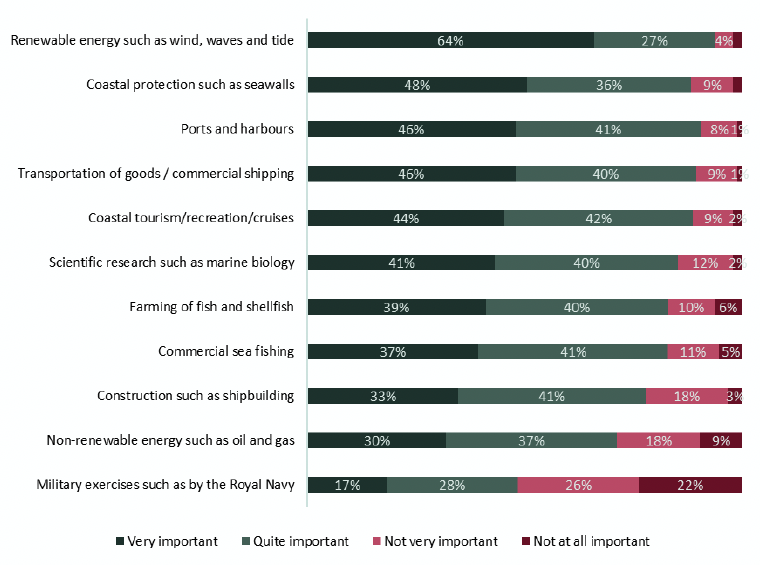
Base: Scottish Residents (National n= 1,000)
Figure 2.2 compares the findings on public perceptions of social value of different marine sectors in Scotland with the same question from the 2019 Marine Social Attitudes survey.[17] The surveys were conducted at different times and using different methodologies so caution should be taken when drawing comparisons. However, it is notable that in most cases the ratings are similar. Differences can be observed between the two surveys for a minority of sectors, notably renewable energy, coastal protection and transportation of goods. The survey does not provide reasons for this difference in perceptions. It is notable, however, that those sectors where opinions have changed have had a higher profile in recent years, due to additional focus on climate change and issues around EU Exit.
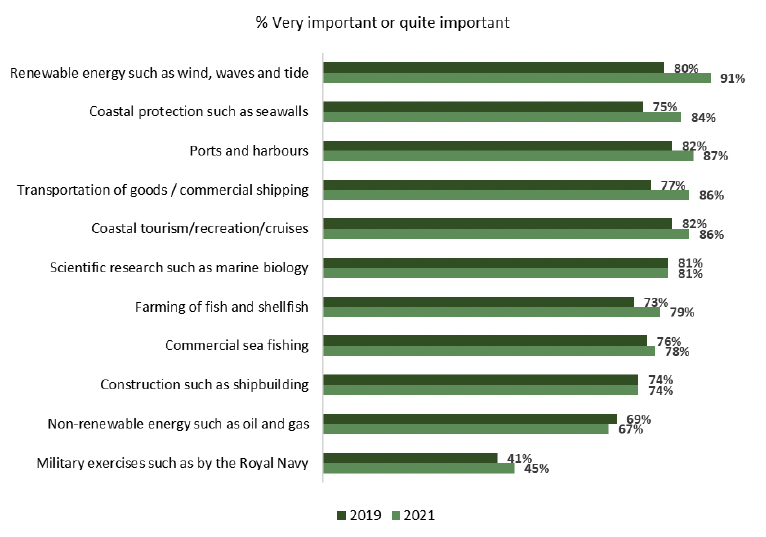
Base: Scottish Residents (2019 n= 2,198, 2021 n= 1,000)
Source: Information taken from Marine Social Attitudes Survey 2019.
Further analysis of this question among national respondents illustrates a high degree of similarity between most demographic sub-groups, such as gender and social class, though different perceptions according to age profiles are worth exploring further. As Figure 2.3 illustrates, in most cases, those in the oldest groups give a higher ranking of social value importance to almost all industries and sectors than those in the youngest age group. The exceptions are coastal tourism and renewable energy which those under 35 rate more highly.
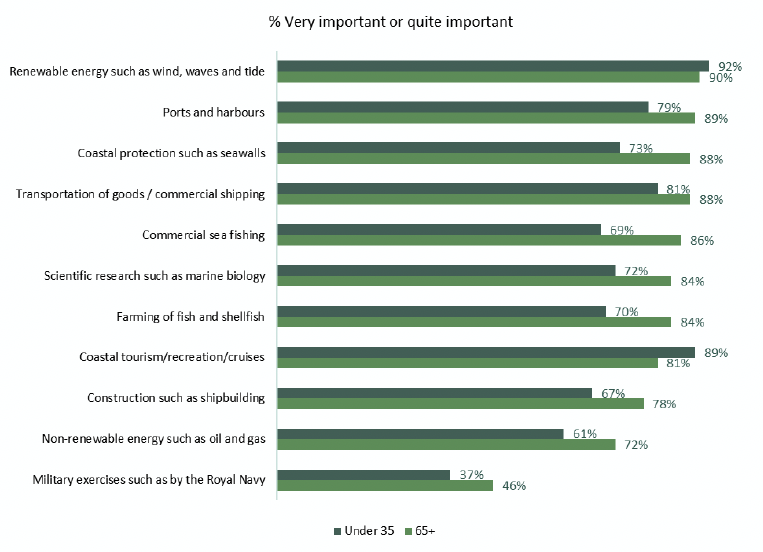
Base: Scottish Residents (National n= 1,000: Under 35 n = 290, 65+ = 230)
2.2 Economic value of marine industries to Scotland
As with the 2019 Marine Social Attitudes Survey, this study asked about the perceived economic value (generating tax revenue, creating and providing jobs) of different marine-based industries. As with perceptions of social value, most national respondents believe renewable energy is an important marine industry in terms of its economic value to Scotland (89% rating as important versus 6% as not important).
In many cases the perceived economic value follows a similar trend to the social value, with the notable exception of coastal protection. For coastal protection, 70% of respondents consider it to be important or very important in terms of its economic value compared to 84% for social value. As with its perceived social value, military exercises are considered of least importance economically with over half (51%) reporting very little or no importance (Figure 2.4).
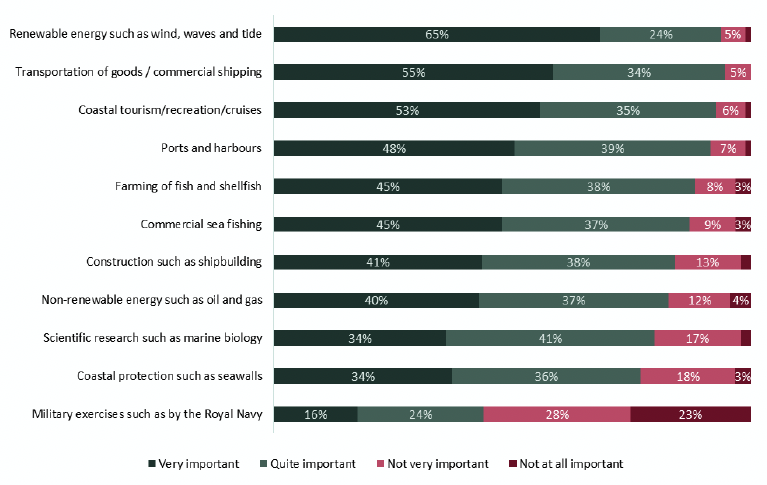
Base: Scottish Residents (National n= 1,000)
When looking at the survey data alongside the 2019 Marine Social Attitudes Survey, one can observe similar patterns when comparing perceptions of economic value and social value. These are presented in Figure 2.5. Once again, caution must be taken when interpreting these findings (for reasons set out above). It is interesting to note, however, that those sectors where opinions have changed, have gained a higher profile in recent years, due to the additional focus on climate change and issues around EU Exit.
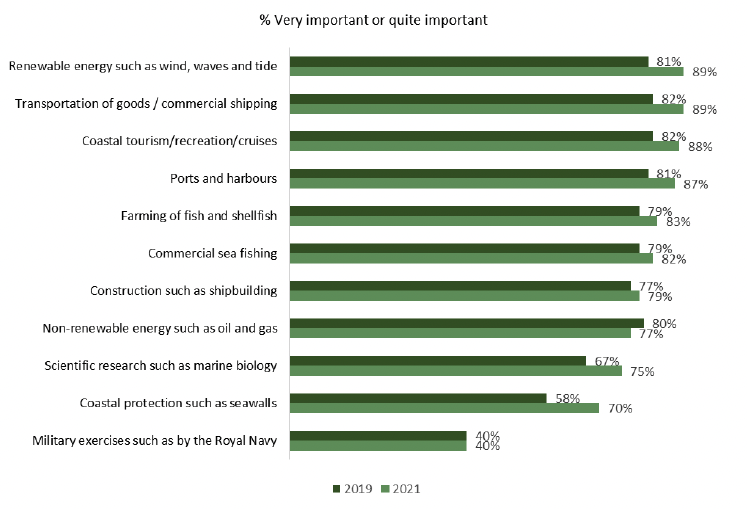
Base: Scottish Residents (2019 n= 2,198, 2021 n= 1,000)
2.3 Issues that affect local areas
Respondents were asked to identify the three most important issues facing their local area, with 'local area' being self-defined by respondents (see Appendix C for full explanation of these definitions).
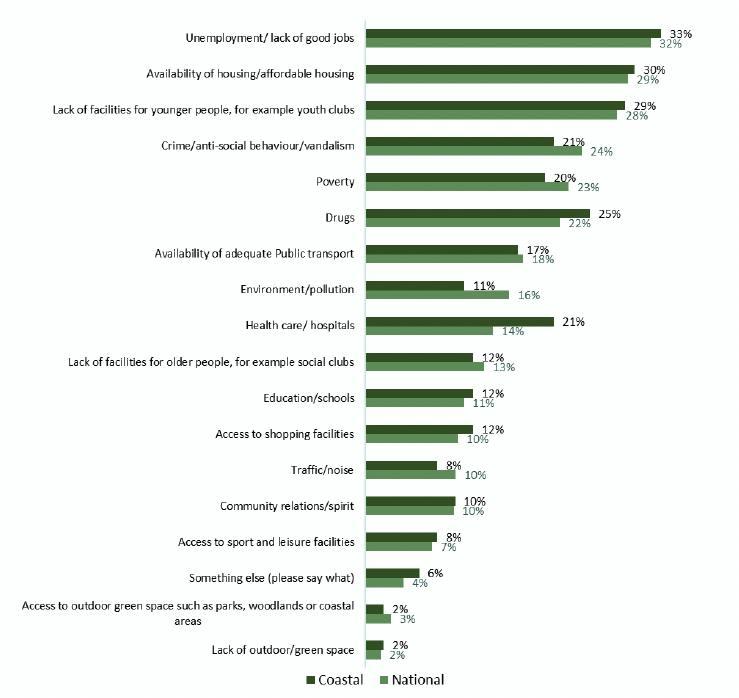
Base: Scottish Residents (National n= 1,000, Coastal n= 1,065)
There was a striking similarity between the views of coastal and national respondents in terms of issues that they saw as being most important (Figure 2.6). For example, a third of national and coastal respondents saw unemployment or a lack of good jobs as an important issue, while around three in ten in both samples believed the availability of affordable housing is an issue in their area as well as a lack of facilities for young people (28% national, 29% coastal). There was a small number of notable differences in opinion between the two samples, such as coastal respondents being more likely to view healthcare or hospitals (21%) in their local area to be an issue compared to 14% among national respondents.
Despite the similarities of opinion between the two samples on this question, there were some notable sub-group differences in the sample of national respondents, including:
- Women (32%) were more likely than men (24%) to view a lack of facilities for younger people as one of the most important issues facing their local area
- Similarly, 16% of women viewed a lack of facilities for older people as an important issue, compared to 10% of men.
- Around a quarter (27%) of those aged 45-54 saw the issue of drugs as important, higher than all other age groups
- The issue of healthcare/hospital may also be related to age, with 21% of those aged 65+ seeing it as the most important issue, versus 7% of those aged 35-44.
- One in eight (12%) of those aged 35–44 thought community relations/spirit were an important issue versus 5% of those aged over 65
- 48% of those in remote rural areas saw the availability of housing/affordable housing as an issue in their local area compared to 25% in accessible rural areas and 27% in accessible small towns.
- 38% of those respondents in remote rural areas thought availability of adequate public transport was an important issue facing their local area versus 13% of those in large urban areas.
- 21% of those respondents in large urban areas thought environment/pollution was an important issue facing their local area versus 13% of those in remote rural areas.
Contact
Email: ScotMER@gov.scot
There is a problem
Thanks for your feedback